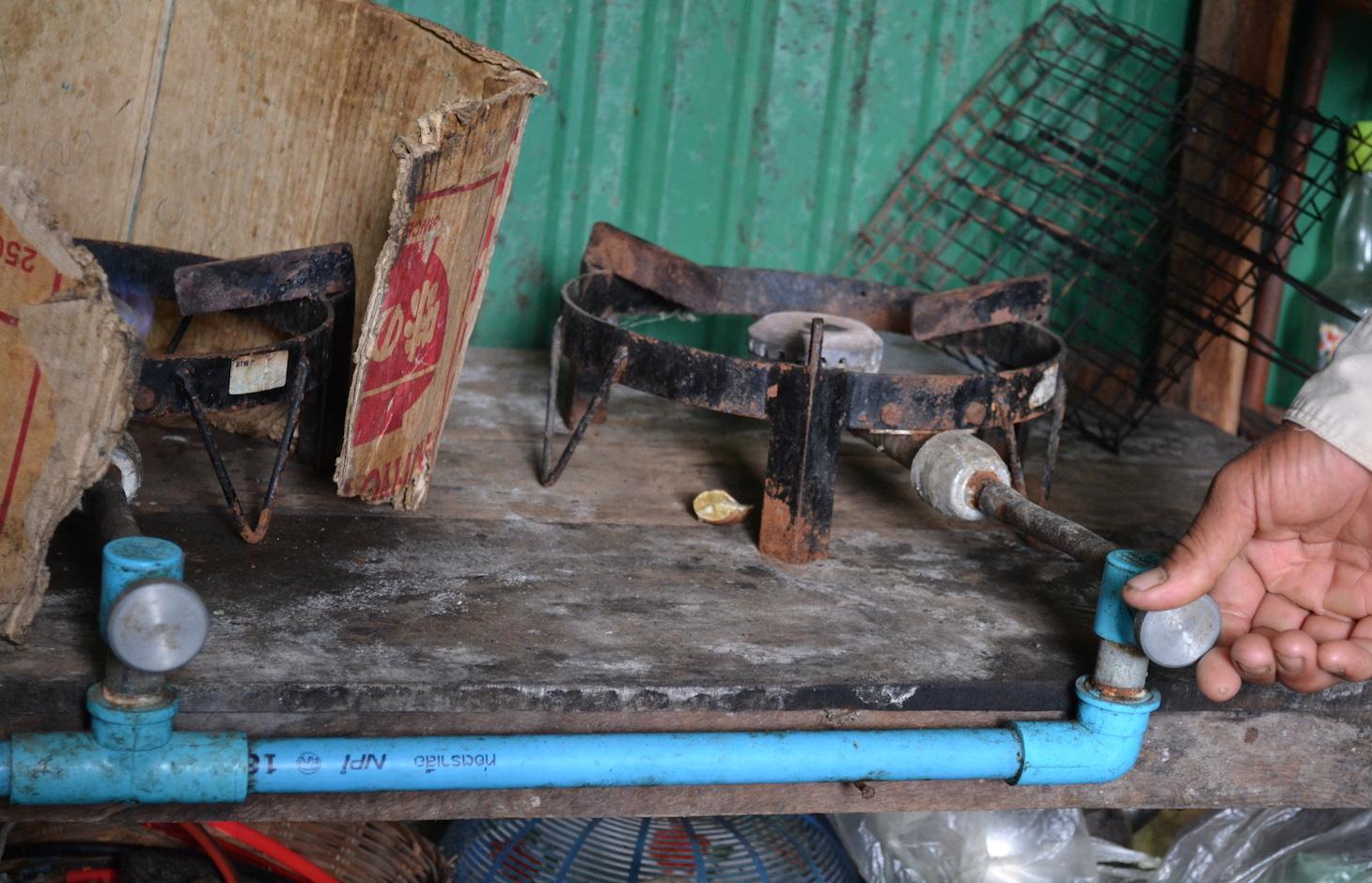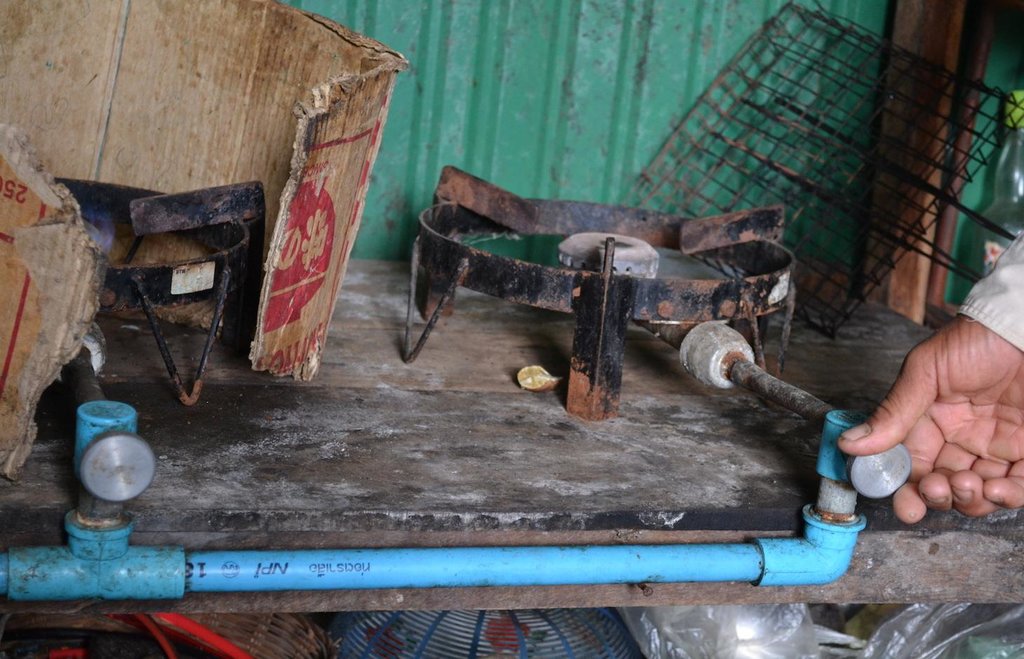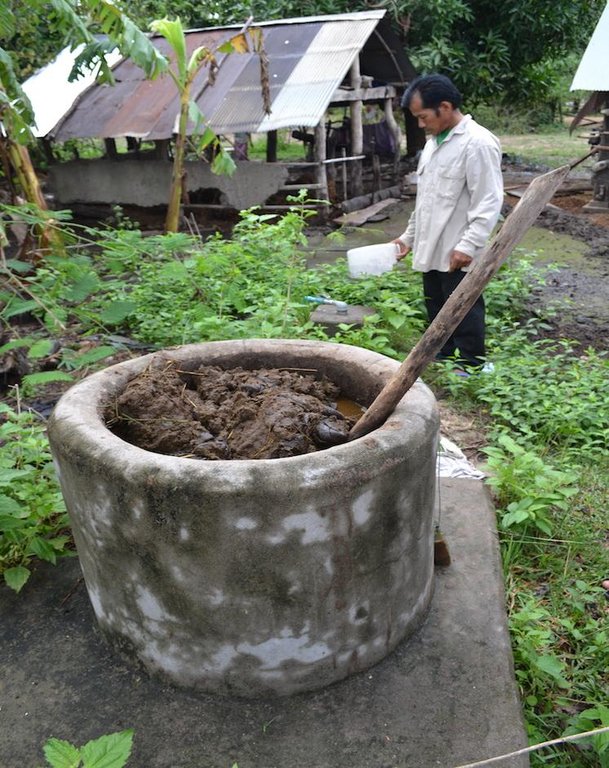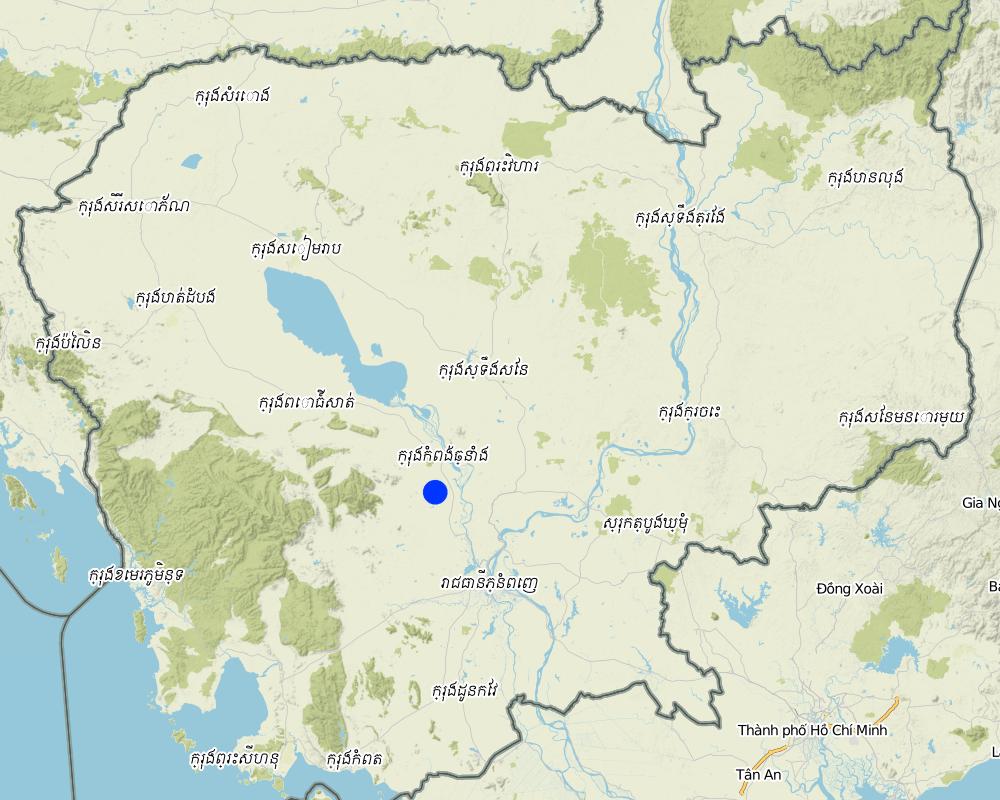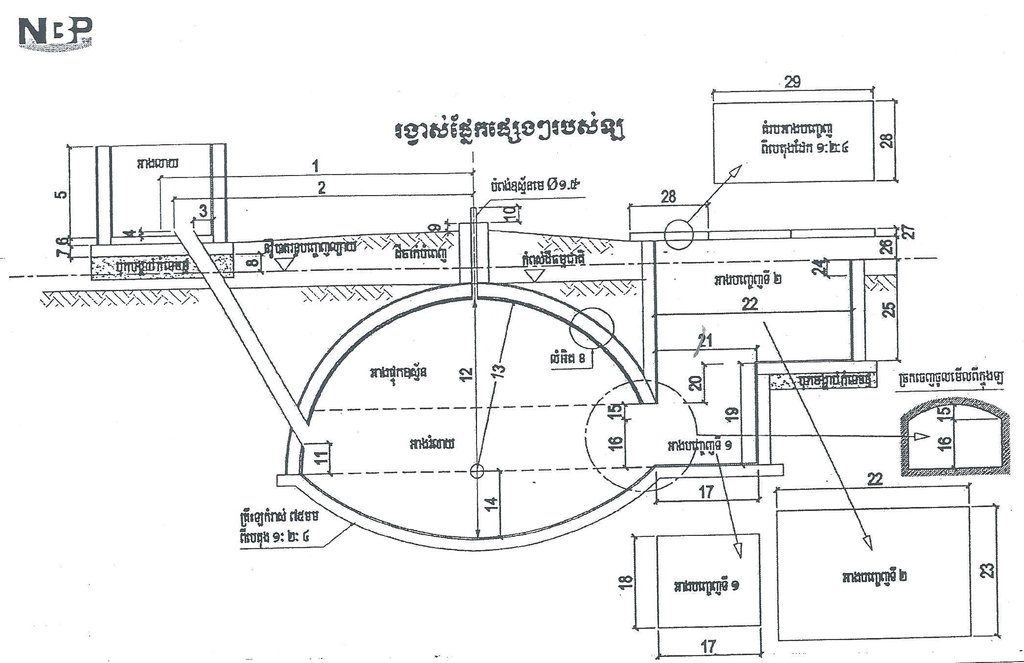Biogas system at household level fed daily with cattle manure [Camboja]
- Criação:
- Atualização:
- Compilador/a: Christoph Kaufmann
- Editor: –
- Revisor: Deborah Niggli
ប្រពន្ធ័ឡជីវៈឧស្ម័នប្រើសំរាប់គ្រួសារប្រចំាថៃ្ងដោយប្រើលាមកគោ (Khmer)
technologies_1645 - Camboja
Veja as seções
Expandir tudo Recolher tudo1. Informação geral
1.2 Detalhes do contato das pessoas capacitadas e instituições envolvidas na avaliação e documentação da tecnologia
Especialista em GST:
Khun Lean Hak
kleanghak@yahoo.com
SOFDEC/LAREC
1.3 Condições em relação ao uso da informação documentada através de WOCAT
Quando os dados foram compilados (no campo)?
05/08/2014
O/a compilador/a e a(s) pessoa(s) capacitada(s) aceitam as condições relativas ao uso de dados documentados através da WOCAT:
Sim
1.4 Declaração de sustentabilidade da tecnologia descrita
A tecnologia descrita aqui é problemática em relação a degradação da terra de forma que não pode ser declarada uma tecnologia de gestão sustentável de terra?
Não
2. Descrição da tecnologia de GST
2.1 Descrição curta da tecnologia
Definição da tecnologia:
Small-scale biogas systems fed with cow manure and water are implemented in order to supply the household with energy for cooking and lighting, as well as to produce fertilizer.
2.2 Descrição detalhada da tecnologia
Descrição:
In this case-study, a small-scale biogas system was introduced in order to generate both energy for home consumption and fertilizer. Small-scale biogas systems are implemented in different parts of the world, however the layout thereof varies considerably.
The model used in this case-study consists of different components (cf. technical drawing). First, there is an inlet where the land user puts cow manure mixed with water. On the bottom of the inlet, there is a board which closes the access to the bio-digester situated beneath the inlet. The board can be opened manually by pulling a string. Once the board is open, the fluid components go through a pipe which leads to the bio-digester. In the bio-digester, bacteria transform the organic matter into biogas (mainly methane and CO2) and slurry. At the other end of the digester, there is another pipe (outlet). The outlet is lower than the inlet, and due to the difference in pressure, the slurry is pushed out of the digester. The slurry is dried and applied to the fields two to three times a year with the help of an ox cart. It has similar effects on the plant growth as chemical fertilizer as it does not build up the soil organic matter as much as compost. The biogas, however, is pushed to the pipe situated on top of the digester and can be utilized for domestic uses. The gas is used for cooking and lighting.
The use of biogas allows reducing the expenses on charging batteries for the lighting, as well as reducing the firewood use (usually from deforestation) for cooking. The slurry reduces the expenses on chemical fertilizer in the fields and has the advantage of killing the weed and rice seeds present in the manure and crop residues.
For building the biogas system, there is governmental and NGO support. These two actors finance half of the construction costs. The other half is paid by the land user. Building a biogas system is quite costly, with about 400 $, and not all of the land users in the area can afford paying 50% of its price. However, the costs borne by the land user are paid off within a few years due to reduced expenses on firewood, chemical fertilizer, and charging batteries. The construction itself was undertaken by local companies.
The costs are paid off within a few years due to the reduced expenses on firewood, chemical fertilizer and battery charging.
The analysed area is flat (slope < 2%), tropic (dry and wet season), and the soils are mostly sandy or loamy. The soils contain little organic matter (low soil fertility, acidification, small amount of cattle, area has been deforested a long time ago) and the groundwater table is rather high (1-3 m during the dry season, on the surface during wet season).
Due to climate change, the rainfalls are more erratic, temperatures rise and droughts are more recurrent. Rice is the predominant crop grown in the area, since it serves as staple food (mix subsistence and commercial activities). Rice is often grown in monocultures and harvested once a year. Once the rice is harvested (dry season), the cattle are released to the paddy fields. The cattle is often replaced by hand tractors, which effects the production of manure but allows a higher amount of crop residues on the fields.
As an addition to rice, most land users grow vegetable and fruits in small home gardens (subsistence) and complement their income by producing handicrafts or through off farm income / remittances from family members working in other places. The increasing migration rate (the young generation leaves the villages to work in the cities, garment industry or abroad) results in a decrease of available labour force in the area which has detrimental effects on the agricultural activities. Furthermore, the civil war in the 1970s (Khmer Rouge) led to the loss of agricultural knowledge which different NGOs try to re-establish.
2.3 Fotos da tecnologia
2.5 País/região/locais onde a tecnologia foi aplicada e que estão cobertos nesta avaliação
País:
Camboja
Região/Estado/Província:
Kampong Chhnang
Especificação adicional de localização:
Sre Ouk Samlor Sap/Taing Krasaing/Rolear Pha,er
Map
×2.6 Data da implementação
Caso o ano exato seja desconhecido, indique a data aproximada:
- menos de 10 anos atrás (recentemente)
2.7 Introdução da tecnologia
Especifique como a tecnologia foi introduzida:
- através de projetos/intervenções externas
Comentários (tipos de projeto, etc.):
LWS (a Dutch NGO) in joint efforts with specialists from the National Biodigester Program NBP. Implementation in 2012
3. Classificação da tecnologia de GST
3.1 Principal/principais finalidade(s) da tecnologia
- Melhora a produção
- Criar impacto econômico benéfico
3.2 Tipo(s) atualizado(s) de uso da terra onde a tecnologia foi aplicada

Terra de cultivo
- Cultura anual

Assentamentos, infraestrutura
- Assentamentos, edificações
- Energia: condutores, linhas elétricas
Comentários:
Major land use problems (compiler’s opinion): Lack of organic matter, lack of water retention in soil, irregularity of rainfall, low soil fertility (sandy soil), monocultures, bare soil during dry season, ploughing.
Major land use problems (land users’ perception): Low soil fertility, lack of water.
Livestock is grazing on crop residues
Constraints of settlement / urban
Constraints of infrastructure network (roads, railways, pipe lines, power lines)
3.3 Mais informações sobre o uso da terra
Número de estações de cultivo por ano:
- 1
Especifique:
Longest growing period in days: 210, Longest growing period from month to month: June-December
3.4 Grupo de GST ao qual pertence a tecnologia
- Tecnologias de eficiência energética
3.5 Difusão da tecnologia
Especifique a difusão da tecnologia:
- Uniformemente difundida numa área
Caso a tecnologia seja uniformemente difundida numa área, indique a área coberta aproximada:
- 0,1-1 km2
Comentários:
There are only 4 households in this village which apply the technology (lack of money and/or cattle). However, similar Technologies are introduced in other provinces – yet it is difficult to estimate the area covered. Estimation for this village.
3.6 Medidas de GST contendo a tecnologia

Medidas estruturais
- S11: Outros

Medidas de gestão
- M6: Gestão de resíduos (reciclagem, reuso ou redução)
Comentários:
Main measures: management measures
Secondary measures: structural measures
3.7 Principais tipos de degradação da terra abordados pela tecnologia

Deteriorização química do solo
- Cn: declínio de fertilidade e teor reduzido de matéria orgânica (não causado pela erosão)
- Ca: acidificação

Degradação biológica
- Bs: Qualidade e composição de espécies/declínio de diversidade
Comentários:
Main causes of degradation: soil management (Ploughing, soil is left bare for several weeks), crop management (annual, perennial, tree/shrub) (Rice monoculture (rice as staple crop)), change of seasonal rainfall (More erratic beginning of wet season), droughts (On dry soil, rice cannot be planted and if already planted, rice cannot grow), labour availability (High migration rates from the villages to garment industry, cities or abroad, influence agricultural activities (e.g. broadcasting instead of transplanting of rice seedlings)), education, access to knowledge and support services (Khmer Rouge regime in the 1970s, a lot of knowledge got lost)
Secondary causes of degradation: over-exploitation of vegetation for domestic use (Rice straw is removed for different domestic uses (cattle, mushroom cultivation, etc.)), overgrazing (Cattle eats rice straw left after harvest, less organic matter on the field, grazing is not managed), change in temperature (More hot days), Heavy / extreme rainfall (intensity/amounts), land tenure (Some incidents of land grabbing, land use rights not clear, corruption), poverty / wealth
3.8 Redução, prevenção ou recuperação da degradação do solo
Especifique o objetivo da tecnologia em relação a degradação da terra:
- Prevenir degradação do solo
- Reduzir a degradação do solo
4. Especificações técnicas, implementação de atividades, entradas e custos
4.1 Desenho técnico da tecnologia
4.2 Especificações técnicas/ explicações do desenho técnico
Biodigester. Inlet: top left; gas outlet: top centre; digestion chambre: centre; and outlet: right. For the comlete building instructions contact the NBP.
Technical knowledge required for field staff / advisors: high (The most challenging part is the construction of the construction of the Biodigester.)
Technical knowledge required for land users: low
Main technical functions: increase in nutrient availability (supply, recycling,…)
Secondary technical functions: increase in organic matter
Structural measure: Biodigester. Round shape. Tiles and concrete.
Width of ditches/pits/dams (m): 4 m^3
Structural measure: Connecting pipes made of plastic
Construction material (concrete): Tiles are covered in concrete.
Construction material (other): The most challenging part is the construction of the Biodigester.
Other type of management: Change of energy supply system for home consumption.
4.3 Informação geral em relação ao cálculo de entradas e custos
Outro/moeda nacional (especifique):
Riel
Indique a taxa cambial do dólar norte americano para a moeda local (se relevante): 1 USD =:
4000,0
Indique a média salarial da mão-de-obra contratada por dia:
5.00
4.4 Atividades de implantação
| Atividade | Tipo de medida | Periodicidade | |
|---|---|---|---|
| 1. | Construction of the biodigester by external experts. The land user did not help with the construction, he only paid 200 US$. The other 200 US$ were paid by the National Biodigester Program. | Estrutural | Dry season, when water table is low. |
4.5 Custos e entradas necessárias para a implantação
| Especifique a entrada | Unidade | Quantidade | Custos por unidade | Custos totais por entrada | % dos custos arcados pelos usuários da terra | |
|---|---|---|---|---|---|---|
| Material de construção | Construction of biodigester | 1,0 | 400,0 | 400,0 | 50,0 | |
| Custos totais para a implantação da tecnologia | 400,0 | |||||
4.6 Atividades recorrentes/manutenção
| Atividade | Tipo de medida | Periodicidade/frequência | |
|---|---|---|---|
| 1. | Add manure and water to the inlet | Gestão | once per day all year round |
| 2. | Collect residuals from biodigester, spread it out and let it dry, and finally put it on the field. | Gestão | 3 times/year |
4.7 Custos e entradas necessárias pata a manutenção/atividades recorrentes (por ano)
| Especifique a entrada | Unidade | Quantidade | Custos por unidade | Custos totais por entrada | % dos custos arcados pelos usuários da terra | |
|---|---|---|---|---|---|---|
| Mão-de-obra | Labour | 1,0 | 121,5 | 121,5 | 100,0 | |
| Custos totais para a manutenção da tecnologia | 121,5 | |||||
Comentários:
Machinery/ tools: Cart to bring residues from the biodigester onto the fields.
The costs were calculated for 1 biodigester with a capacity of 4 m3.
4.8 Fatores mais importantes que afetam os custos
Descreva os fatores mais determinantes que afetam os custos:
The most costly part of this Technology is the construction of the biodigester. Once the system is installed, the costs borne by the land user are low. Also, the land user can save money since he doesn’t need to buy firewood any more.
5. Ambiente natural e humano
5.1 Clima
Precipitação pluviométrica anual
- <250 mm
- 251-500 mm
- 501-750 mm
- 751-1.000 mm
- 1.001-1.500 mm
- 1.501-2.000 mm
- 2.001-3.000 mm
- 3.001-4.000 mm
- > 4.000 mm
Especificações/comentários sobre a pluviosidade:
1486.45 mm 2013 in Kampong Chhnang
Zona agroclimática
- Subúmido
27° to 35°C, 1486.45 mm 2013 in Kampong Chhnang
5.2 Topografia
Declividade média:
- Plano (0-2%)
- Suave ondulado (3-5%)
- Ondulado (6-10%)
- Moderadamente ondulado (11-15%)
- Forte ondulado (16-30%)
- Montanhoso (31-60%)
- Escarpado (>60%)
Formas de relevo:
- Planalto/planície
- Cumes
- Encosta de serra
- Encosta de morro
- Sopés
- Fundos de vale
Zona de altitude:
- 0-100 m s.n.m.
- 101-500 m s.n.m.
- 501-1.000 m s.n.m.
- 1.001-1.500 m s.n.m.
- 1.501-2.000 m s.n.m.
- 2.001-2.500 m s.n.m.
- 2.501-3.000 m s.n.m.
- 3.001-4.000 m s.n.m.
- > 4.000 m s.n.m.
5.3 Solos
Profundidade do solo em média:
- Muito raso (0-20 cm)
- Raso (21-50 cm)
- Moderadamente profundo (51-80 cm)
- Profundo (81-120 cm)
- Muito profundo (>120 cm)
Textura do solo (solo superficial):
- Grosso/fino (arenoso)
- Médio (limoso, siltoso)
Matéria orgânica do solo superficial:
- Médio (1-3%)
- Baixo (<1%)
5.4 Disponibilidade e qualidade de água
Lençol freático:
< 5 m
Disponibilidade de água de superfície:
Precário/nenhum
Qualidade da água (não tratada):
Água potável precária (tratamento necessário)
Comentários e outras especificações sobre a qualidade e a quantidade da água:
Ground water tabel and availability of surface water data during dry seasons. People use water for drinking after filtering or boiling.
5.5 Biodiversidade
Diversidade de espécies:
- Baixo
Comentários e outras especificações sobre biodiversidade:
Only degraded forests are in the area.
5.6 Características dos usuários da terra que utilizam a tecnologia
Sedentário ou nômade:
- Semi-nômade
Orientação de mercado do sistema de produção:
- Misto (subsistência/comercial)
Rendimento não agrícola:
- 10-50% de toda renda
Nível relativo de riqueza:
- Rico
Indivíduos ou grupos:
- Indivíduo/unidade familiar
Gênero:
- Mulheres
- Homens
Indique outras características relevantes dos usuários da terra:
Land users applying the Technology are mainly Leaders / privileged
Population density: 10-50 persons/km2
Annual population growth: 0.5% - 1%
Off-farm income specification: Handicraft, remittances and factory work.
5.7 Média da área de terra própria ou arrendada por usuários da terra que utilizam a tecnologia
- < 0,5 ha
- 0,5-1 ha
- 1-2 ha
- 2-5 ha
- 5-15 ha
- 15-50 ha
- 50-100 ha
- 100-500 ha
- 500-1.000 ha
- 1.000-10.000 ha
- > 10.000 ha
É considerado pequena, média ou grande escala (referente ao contexto local)?
- Média escala
5.8 Propriedade de terra, direitos de uso da terra e de uso da água
Propriedade da terra:
- Comunitário/rural
- Indivíduo, não intitulado
Direitos do uso da terra:
- Comunitário (organizado)
- Indivíduo
Direitos do uso da água:
- Acesso livre (não organizado)
Comentários:
Land ownership is very complex. Most of the land belongs officially to the government, yet many land users hold a paper confirming they applied for a land title – but de iure, this paper is worthless.
5.9 Acesso a serviços e infraestrutura
Saúde:
- Pobre
- Moderado
- Bom
Educação:
- Pobre
- Moderado
- Bom
Assistência técnica:
- Pobre
- Moderado
- Bom
Emprego (p. ex. não agrícola):
- Pobre
- Moderado
- Bom
Mercados:
- Pobre
- Moderado
- Bom
Energia:
- Pobre
- Moderado
- Bom
Vias e transporte:
- Pobre
- Moderado
- Bom
Água potável e saneamento:
- Pobre
- Moderado
- Bom
Serviços financeiros:
- Pobre
- Moderado
- Bom
6. Impactos e declarações finais
6.1 Impactos no local mostrados pela tecnologia
Impactos socioeconômicos
Produção
Produção agrícola
Comentários/especificar:
Dried residues are put in the garden (cucumber, pumpkin, watermelon) which increases nutrient availability.
Geração de energia
Renda e custos
Despesas com insumos agrícolas
Comentários/especificar:
He saves 50 $ on chemical fertilizer per year.
Impactos socioculturais
Estado de saúde
Comentários/especificar:
No smoke from open fire.
Contribution to human well-being
Comentários/especificar:
On the long term livelihood is improved, because he saves over 60 $ per year in firewood and battery charging for light, as well as 50 $ for chemical fertilizer.
Impactos ecológicos
Ciclo hídrico/escoamento
Qualidade de água
Comentários/especificar:
Pollution of groundwater due to washing out of nutrients.
Solo
Matéria orgânica do solo/carbono abaixo do solo
Comentários/especificar:
Most of the carbon is transformed into methane, not available as organic matter.
Outros impactos ecológicos
weed seeds
Comentários/especificar:
Compost usually not completely decomposed, as well as raw manure, contain lots of weed seeds.
energy generation (eg hydro, bio)
Comentários/especificar:
Before the installation of the biogas system, the land user bought firewood.
deforestation for firewood
6.2 Impactos externos mostrados pela tecnologia
Poluição de água subterrânea/rio
Comentários/especificar:
Sludge is left to dry outside, nutrients washed out into groundwater. Not measurable.
6.3 Exposição e sensibilidade da tecnologia às mudanças climáticas graduais e extremos/desastres relacionados ao clima (conforme o ponto de vista dos usuários da terra)
Mudança climática gradual
Mudança climática gradual
| Estação do ano | Tipo de mudança climática/extremo | Como a tecnologia lida com isso? | |
|---|---|---|---|
| Temperatura anual | aumento | bem |
Extremos (desastres) relacionados ao clima
Desastres meteorológicos
| Como a tecnologia lida com isso? | |
|---|---|
| Temporal local | bem |
| Tempestade de vento local | bem |
Desastres climatológicos
| Como a tecnologia lida com isso? | |
|---|---|
| Seca | bem |
Desastres hidrológicos
| Como a tecnologia lida com isso? | |
|---|---|
| Inundação geral (rio) | não bem |
Outras consequências relacionadas ao clima
Outras consequências relacionadas ao clima
| Como a tecnologia lida com isso? | |
|---|---|
| Período de crescimento reduzido | bem |
6.4 Análise do custo-benefício
Como os benefícios se comparam aos custos de implantação (do ponto de vista dos usuários da terra)?
Retornos a curto prazo:
negativo
Retornos a longo prazo:
muito positivo
Como os benefícios se comparam aos custos recorrentes/de manutenção(do ponto de vista dos usuários da terra)?
Retornos a curto prazo:
muito positivo
Retornos a longo prazo:
muito positivo
6.5 Adoção da tecnologia
- mais que 50%
Se disponível, determine a quantidade (número de unidades familiares e/ou área abordada):
100% or 4 land user families
Comentários:
100% of land user families have adopted the Technology with external material support
4 land user families have adopted the Technology with external material support
The farmers can ask the National Biodigester Program for subsidies, but need to pay half of it on their own. As the farmers often lack money and need at least 3 - 4 heads of cattle to produce enough manure while they switch more and more to hand tractors, not many farmers are building new biogas digesters.
6.7 Pontos fortes/vantagens/oportunidades da tecnologia
| Pontos fortes/vantagens/oportunidades na visão do usuário da terra |
|---|
| Fertilizer production (sludge). |
| Saves money and time on the cooking fuel (previously wood) and electricity (charging batteries) for the light. |
| No weed seeds in the sludge compared to compost and raw manure if used as fertilizer. |
| Pontos fortes/vantagens/oportunidades na visão do/a compilador/a ou de outra pessoa capacitada |
|---|
| Less deforestation for firewood. |
6.8 Pontos fracos, desvantagens/riscos da tecnologia e formas de superá-los
| Pontos fracos/desvantagens/riscos na visão do usuário da terra | Como eles podem ser superados? |
|---|---|
| The residue does not improve the soil as much as compost. | Make compost in addition to biogas to enhance the soil organic matter. |
| The building costs are prohibitive | Increase subsidies from state or NGOs. |
| At least 3-4 heads of cattle or 4-5 pigs have to be kept to produce enough manure. | Diversify production with different animals. |
| Work has to be done each day to produce biogas. |
| Pontos fracos/vantagens/riscos na visão do/a compilador/a ou de outra pessoa capacitada | Como eles podem ser superados? |
|---|---|
| Overgrazing could become a problem as more cattle needs to be kept. | Add slurry as a liquid fertilizer |
| Part of nitrogen is volatilized during the drying of the sludge. |
7. Referências e links
7.1 Métodos/fontes de informação
- visitas de campo, pesquisas de campo
- entrevistas com usuários de terras
7.2 Referências às publicações disponíveis
Título, autor, ano, ISBN:
NBP National Biodigester Program
Disponível de onde? Custos?
www.nbp.org.kh
Título, autor, ano, ISBN:
Lam et al. 2009. Domestic Biogas Compact Course. University of Oldenburg.
Disponível de onde? Custos?
http://www.nbp.org.kh/publication/study_report/2_domestic_biogas%20.pdf
Título, autor, ano, ISBN:
Gurung. 2009. Review of Literature on Effects of Slurry Use on Crop production. The Biogas Support Program
Links e módulos
Expandir tudo Recolher tudoLinks
Não há links
Módulos
Não há módulos


